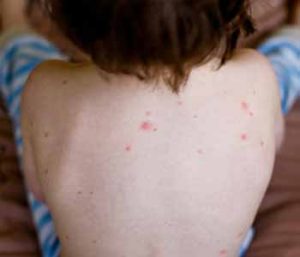Here at Dulles Dermatology Associates, now a part of U.S. Dermatology Partners, we offer a wide range of services and quality care for patients of all ages from Dulles, Gainesville, and other area communities. We understand that babies and kids have very unique dermatological needs. We also understand that parents need information, support, and answers. One of the most common questions is, “What is that rash, and should I be worried?”
Does my child need a dermatologist?
Some rashes are temporary and harmless. However, certain skin conditions can pose a serious health risk, or they may be a symptom of another medical problem. Parents often ask how to tell when it’s time to seek medical care.
Signs that it is time to see a dermatologist include:
- A skin problem that interferes with daily life, including social embarrassment
- Sudden rash developing soon after taking medication or exposure to other potential allergens
- Skin lesions that resemble bruises, or that don’t change color when you press on the skin
- Your child is experiencing pain or uncontrollable itching
- Any rash accompanied by other symptoms such as fever
- Any rash or skin condition that has not resolved within three days
- When in doubt, it is always best to see a dermatologist for an accurate diagnosis.
Call our office at (844) 357-3376 or click here to Request an Appointment!
Common childhood skin conditions: Know the symptoms
-
- Ringworm: No, it isn’t caused by worms. This common fungal infection usually begins as a scaly lesion, which may be flat or raised. It often itches, but not always. The most distinctive sign of ringworm is a dark red margin around the lesion, which develops as it progresses.
- Fifth disease: This illness begins with flu-like symptoms. As it progresses, skin symptoms such as body rashes and a severely flushed face develop. Fifth disease is usually mild, but take precaution if your child is affected because it is contagious. A pregnant woman who has been exposed to fifth disease should see a doctor right away.
-
- Chickenpox: Thankfully, this once-prevalent disease is now quite uncommon. However, it is extremely contagious to anyone who has not been vaccinated. Chickenpox is characterized by intense itching and red lesions covering the body. As they develop they become blisters, which then burst and become crusty.
- Impetigo: A bacterial infection, impetigo manifests as reddish blisters or sores that ooze and crust over. Impetigo lesions most often develop on the face, especially around the mouth. However, they can appear anywhere.
- Warts: These familiar bumps are typically harmless. They are usually painless and gradually go away without treatment. However, they can become sore if they are in an area subjected to frequent pressure or friction. It is important to know that warts are caused by a contagious virus; frequent handwashing is essential to prevention.
- Heat rash: Also called prickly heat, this condition results from blocked sweat glands. It is characterized by one or several patches of small, pink to red pimple-like bumps, usually around the head and shoulder area of infants. Any child can be affected during hot weather, but the most common cause is well-meaning parents overdressing a baby on cool days.
- Contact dermatitis: This is a common rash among children and adults alike. It is a skin reaction, either to irritants or allergens. There is usually redness and a bumpy rash, often with itching. Depending on the severity, the area may swell and blister. Contact dermatitis may be caused by poison ivy, harsh soap, chemicals, certain types of fabrics, metals such as nickel, and many other substances. If your child experiences this problem frequently, an allergy test may be required in order to determine the trigger.
- Coxsackie: Better known by its common name, hand-foot-mouth disease, this condition is not as serious as it sounds. It is quite common, and usually begins with a fever, followed by blisters and a rash developing around the mouth, on the feet and legs, on the hands, and sometimes the buttocks. It typically resolves within a couple of weeks, but is quite contagious, spread by sneezing and coughing.
- Roseola: You may know this condition by its nickname, “sixth disease,” which is a reference to its position on a well-known list of the six most common childhood skin diseases. It typically develops between the ages of six months and two years. It begins with cold symptoms, followed by a fever, then a pink, raised skin rash.
- Hives: This rash manifests as pinkish or reddish lesions, which may vary in size or shape, accompanied by intense itching. It may be triggered by allergies to food, medication, or other substances, or it may occur as a side effect of illness. Although quite common, hives can be a sign of a very serious problem.
- Scarlet fever: Characterized by bright red (scarlet) skin, this rash accompanies strep throat. Other symptoms may include swollen glands in the neck, stomach pain, fever, headache, and a sore throat.
- Eczema: One of the most common and best-known childhood skin conditions, eczema is characterized by itchy, dry skin. Children with this condition are likely to suffer from asthma, allergies, immune deficiencies, or other health concerns. Though it is not immediately curable, the symptoms can be managed. Most, though not all, children outgrow eczema.
If you have any concerns about your child’s skin – or about your own – please call us at (844) 357-3376 to schedule a consultation.
Click here to Request a Consultation Online!



